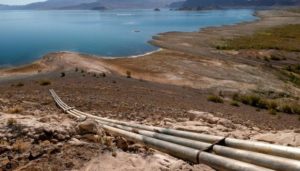Sure looks like it.
It’s simple math. Lake Mead’s surface elevation is 1,071 feet, and is dropping by 20 feet a year; when it reaches 895 feet, no water comes out at the bottom of the dam.
That means the Colorado River dries up and Hoover Dam stops generating electricity 9 years from now, in the summer of 2030, but only if the rate of water loss doesn’t increase. Otherwise, sooner.
No drinking water for Las Vegas. No electricity for 25 million customers. No irrigation water for farmers and Native American tribes in Arizona, New Mexico, and southern California. And there’s nothing anybody can do about it, except maybe move to somewhere else.
But at least ocean beachfront building lots in Alaska and Siberia are coming.
Read story here. Related: The West faces a “scary water future” (read that story, and about possible solutions, here).
Photo below: Las Vegas water supply

The dam has been doing its basic function since the drought began in 2000. Water control. With no dam there would not be a Lake Roosevelt, and the river would have gone dry at some points over the past 20 years. The dam has paid for itself and more with the power it has already generated. Las Vegas is a city that should not exist…something about the size of the Mormon settlement it once was. LA though should not exist and does rely on water from the dam.
Lake Roosevelt is in Washington State. The reservoir behind Hoover Dam is Lake Mead. The dam has nothing to do with whether the Colorado River goes dry; upstream, that’s entirely a function of the mountain snowpacks that are the river’s water source; downstream, it’s a function of how much water is withdrawn from the river relative to how much water is in the river (the Colorado River has been overappropriated, and hasn’t reached the Pacific Ocean, for many years now). The impact of the drought is less snowfall, less water entering the river; the impact of rapid population growth in the Colorado River basin is more demands on a shrinking water supply. Something has to give, and because agriculture is by far the biggest water user, that’s where the water cutbacks will occur — and hit hardest.